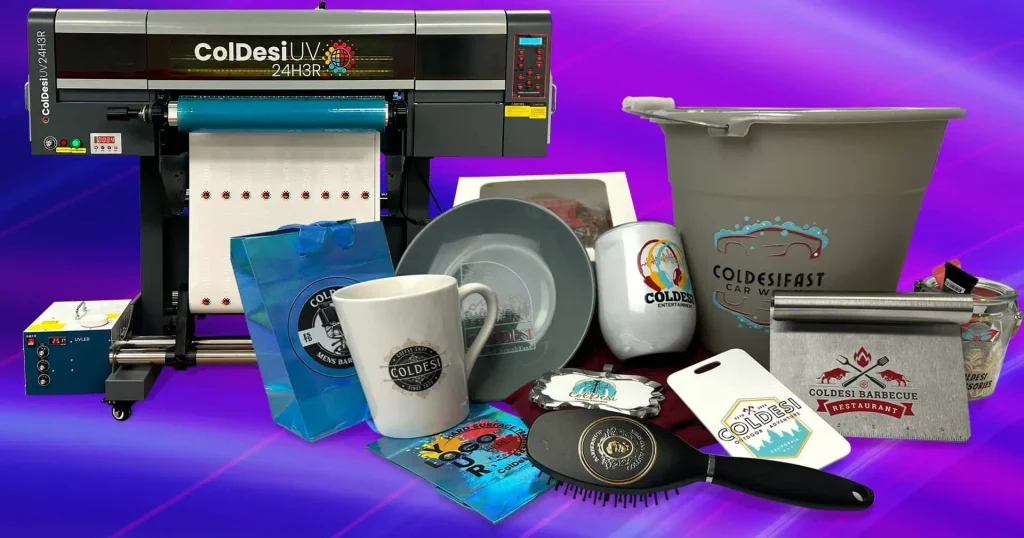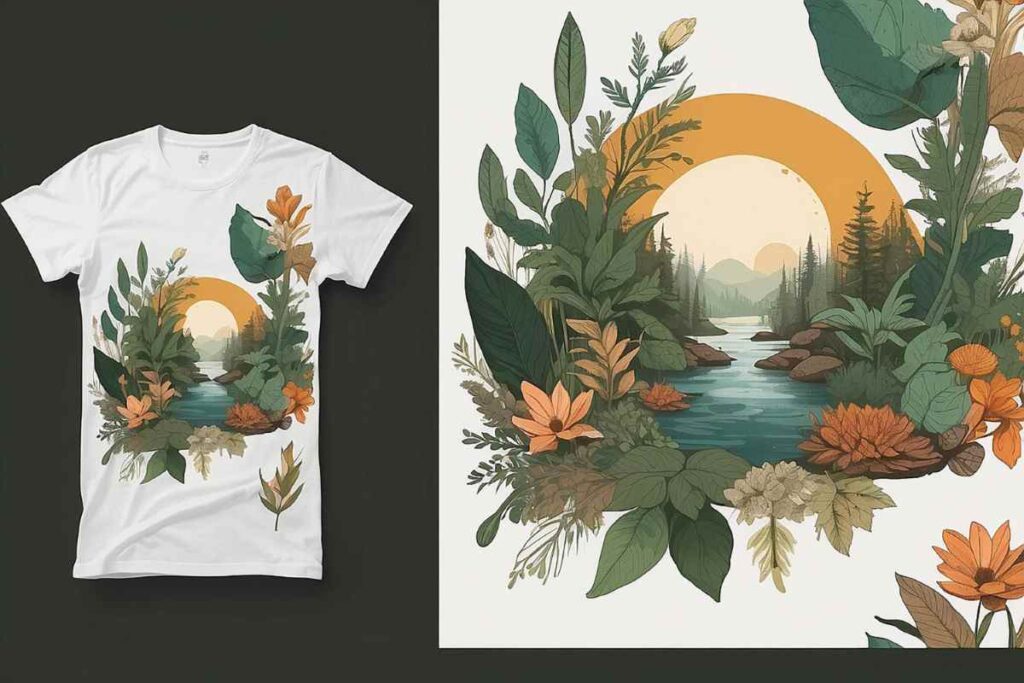UV DTF printing has emerged as a groundbreaking technology in the realm of UV printing technology, revolutionizing the way vibrant prints are created and transferred onto a myriad of surfaces. This innovative method leverages ultraviolet light to cure inks rapidly, resulting in prints that are not only visually striking but also remarkably durable. As businesses increasingly seek to produce custom merchandise that stands out, UV DTF printing provides an efficient solution that caters to the rising demand for personalized products across various industries. With its ability to print on diverse materials such as textiles and plastics, this direct to film printing process minimizes waste, promoting sustainable printing practices. Ultimately, UV DTF printing is setting the stage for a new era of high-quality, eco-friendly printing solutions that capture both imagination and consumer interest.
Introducing the world of ultraviolet direct to film printing, a technological marvel that combines speed and precision in producing eye-catching designs. This advanced printing method is transforming how brands create customized merchandise, catering to the growing desire for unique, personalized items. By utilizing UV curing technology, this process not only enhances print quality but also embraces a commitment to sustainable practices, reducing environmental footprint compared to traditional approaches. The versatility of this technique allows businesses to explore a wide range of applications, making it ideal for industries needing vibrant and durable solutions. As we delve into the capabilities of this dynamic printing method, it becomes clear that its potential for innovation is limitless.
Understanding UV DTF Printing Technology
UV Direct to Film (DTF) printing represents a significant advancement in the landscape of printing technology, merging the precision of UV printing with the versatility of direct-to-film applications. This innovative approach utilizes specialized inks that are cured using ultraviolet light, resulting in quick drying times and a vibrant finish. Unlike traditional printing methods that may impose limitations on material types and color vibrancy, UV DTF allows for a wide range of substrates, including textiles, plastics, and metals, making it ideal for a variety of applications from custom merchandise to promotional materials.
Moreover, the UV DTF printing process ensures that high-definition images are transferred with precision onto each surface, maintaining the integrity and detail of the original designs. This technology stands out particularly in sectors seeking personalized and intricate designs, as businesses can create custom items tailored to individual consumer preferences, thus enhancing customer satisfaction and engagement. As such, the appeal of UV DTF printing continues to rise across various industries, including fashion, home decor, and advertising.
Benefits of UV DTF Printing: Sustainability and Quality
One of the standout benefits of UV DTF printing is its commitment to sustainability. Unlike many traditional printing practices that utilize solvents and chemicals, UV DTF printing significantly reduces the environmental impact of production. The elimination of harmful substances means that businesses can produce high-quality prints while adhering to eco-friendly practices. This shift towards sustainable printing not only caters to the growing consumer demand for environmentally conscious products but also aligns with the goals of manufacturers aiming to minimize their carbon footprint.
Additionally, the durability of prints produced through UV DTF technology cannot be overlooked. The curing process achieved through ultraviolet light enhances the longevity of the graphics, making them resistant to fading, scratching, and wear. This allows businesses to provide products that not only look vibrant upon purchase but continue to do so over time, significantly improving customer satisfaction. By leveraging the capabilities of UV DTF printing, companies can remain competitive in an increasingly demanding market, pledging both quality and sustainability.
Applications of UV DTF Printing: Beyond Apparel
While UV DTF printing is making waves in the fashion and apparel industry, its applications extend far beyond clothing. This versatile technology is finding a strong foothold in the production of promotional products, branded merchandise, and even industrial applications. Items such as custom promotional bags, signage, and specialized packaging are increasingly being crafted using UV DTF methods, showcasing the technology’s adaptability across diverse material types and industries.
Moreover, businesses are capitalizing on the ability to print intricate and colorful designs on a multitude of surfaces, from hard materials like wood and metal to softer fabrics. As brands recognize the importance of personalized and unique products in capturing consumer attention, UV DTF printing serves as a vital tool, empowering companies to create items that not only meet customer expectations but set them apart in a competitive marketplace.
Market Trends Fueling UV DTF Adoption
The surge in demand for personalized products is a primary factor driving the adoption of UV DTF printing technology. Modern consumers are increasingly seeking out unique, custom items that reflect their individual tastes and styles, a trend that has significantly influenced the product offerings of many businesses. In response, companies are leveraging UV DTF printing to fulfill these demands, producing customized merchandise that resonates with a consumer base eager for bespoke solutions.
Additionally, the pressing need for businesses to adopt sustainable practices has also contributed to the popularity of UV DTF printing technology. As consumers become more environmentally conscious, companies strive to align their production processes with sustainable methods. UV DTF printing’s reduced reliance on harmful chemicals not only meets regulatory standards but also appeals to consumers looking for eco-friendly options. This combination of personalization and sustainability is pushing businesses to rethink their printing methods, further solidifying UV DTF printing as a staple in modern manufacturing.
Innovations Shaping the Future of UV DTF Printing
The landscape of UV DTF printing is continuously evolving, with ongoing innovations that promise to enhance efficiency and broaden application potential. Advances in ink technology and curing processes are enabling printers to achieve higher resolutions and quicker production speeds, ensuring that businesses can meet the growing demand for custom items without sacrificing quality. As these technologies develop, the barriers to entry for smaller businesses eager to adopt UV DTF methods will continue to shrink, democratizing access to advanced printing solutions.
Moreover, the integration of digital technologies and automation in the UV DTF printing process is poised to revolutionize the industry further. With digital design software improving accessibility for creatives and automated manufacturing processes enhancing output consistency, the future of UV DTF printing holds tremendous promise for companies of all sizes. These innovations not only streamline production but also enrich the creative possibilities available to designers, inviting them to push boundaries in the realm of custom prints.
Real-World Success Stories with UV DTF Printing
Several companies have successfully integrated UV DTF printing into their operations, showcasing the transformative potential of this technology. For instance, a notable startup in the custom apparel sector adopted UV DTF printing techniques, leading to a remarkable increase in production efficiency and customer engagement. Their ability to rapidly produce vibrant, eye-catching designs significantly contributed to bolstering their brand presence in a competitive market.
Similarly, a promotional products company experienced a marked uplift in demand after implementing UV DTF printing into their offerings. By focusing on customization and high-quality designs, they managed to capture new clientele and enhance customer loyalty. These case studies not only underscore the practical advantages of adopting UV DTF technology but also illustrate how businesses can leverage it to differentiate themselves from competitors through innovative product offerings.
Frequently Asked Questions
What are the benefits of using UV DTF printing for custom merchandise?
UV DTF printing offers numerous benefits for custom merchandise, including vibrant prints, high durability, and quick production times. This technology allows businesses to produce unique, high-quality products on various materials while minimizing waste, promoting more sustainable printing practices.
How does UV Direct to Film printing compare to traditional UV printing?
UV Direct to Film (DTF) printing differs from traditional UV printing in that it specifically utilizes a film substrate for transferring designs, allowing for intricate details and color vibrancy. Additionally, UV DTF technology enhances versatility by enabling prints on diverse surfaces, making it ideal for custom applications.
Is UV DTF printing sustainable, and how does it reduce environmental impact?
Yes, UV DTF printing is a sustainable printing method as it reduces the reliance on solvents and harmful chemicals common in traditional printing. The process emits fewer volatile organic compounds (VOCs), making it a cleaner option for manufacturers looking to lessen their environmental footprint while producing vibrant prints.
Can UV DTF printing be applied to promotional items and event giveaways?
Absolutely! UV DTF printing is perfect for promotional items and event giveaways. It allows for customization on various substrates, such as plastics and metals, ensuring that brands can create eye-catching, personalized products that resonate with targeted audiences.
What industries benefit most from adopting UV DTF printing technology?
Several industries benefit from UV DTF printing technology, including fashion, advertising, and custom merchandise production. Its ability to deliver high-quality, durable prints makes it ideal for garment designers, promotional product companies, and businesses focusing on personalizing customer experiences.
What materials can be printed using UV DTF technology?
UV DTF technology can print on a wide range of materials, including textiles, plastics, metals, and more. This versatility makes it an excellent choice for businesses looking to produce vibrant prints on diverse products, from apparel to promotional items.
| Key Aspect | Details |
|---|---|
| Overview of UV DTF Technology | Merges ultraviolet curing tech with direct-to-film methods for high-quality graphic designs on various surfaces. |
| Innovation and Efficiency | Allows printing on multiple materials, enhancing production efficiency and sustainability. |
| Market Trends | Growing demand for customized products leads businesses to adopt UV DTF printing. |
| Applications | Used in fashion, promotional items, and various industries showcasing high-quality printing. |
| Environmental Impact | More eco-friendly compared to traditional printing; reduces reliance on harmful chemicals. |
Summary
UV DTF printing is revolutionizing the printing industry by combining advanced technology with creative possibilities. This cutting-edge method not only enhances the quality of prints but also introduces significant efficiencies in production, making it a game-changer for various sectors. As customized and personalized products become increasingly popular, embracing UV DTF printing offers businesses a pathway to meet consumer demands while also addressing sustainability concerns. Innovators in fashion and promotional products are already leveraging this technology to differentiate themselves in the market, and the future looks promising. The ability to produce vibrant, durable prints on diverse materials ensures that UV DTF printing will continue to play a crucial role in shaping the future of manufacturing.


